Mana Mitra: Andhra Pradesh’s WhatsApp Governance Model
- 24 Sep 2025
In News:
- The Central Government, through the Department of Administrative Reforms and Public Grievances (DARPG), has decided to study and replicate Andhra Pradesh’s “WhatsApp Governance Model”, recognized as a national best practice in e-governance.
- The announcement came during the 28th National Conference on e-Governance 2025, held in Visakhapatnam on the theme “Viksit Bharat: Civil Service and Digital Transformation.”
About Mana Mitra
- Mana Mitra, launched by the Andhra Pradesh government in January 2025, is India’s first WhatsApp-based governance platform.
- It integrates 36 departments and provides 738 citizen services through a single WhatsApp number — 9552300009 — ensuring accessibility, efficiency, and transparency in public service delivery.
Objectives
- Ease of Access: Deliver services through WhatsApp, a widely used platform, reducing citizens’ dependence on physical offices.
- Transparency & Trust: Digital certificates are issued with QR-coded verification, minimizing fraud and fake documentation.
- Inclusivity: Brings governance to the mobile phones of rural and remote citizens, fostering last-mile digital inclusion.
How It Works
- Single-Number Access: Citizens initiate a chat by sending “Hi” on WhatsApp.
- Menu-Driven Services: A chatbot guides users through departments and available services—education, revenue, endowments, RTC, tourism, and health.
- Instant Document Delivery: Documents such as income and caste certificates, hall tickets, and tax receipts are generated digitally with verifiable QR codes.
- Real-Time Dashboard: Tracks service delivery, ensuring accountability and performance monitoring.
- Next-Gen Tech Integration: Future phases will use AI chatbots, voice-based assistance, and blockchain authentication for secure transactions.
Key Features
- Wide Coverage: 738 services across 36 departments.
- Security: Built-in encryption and QR verification to prevent misuse.
- Partnership with Meta: Ensures robust backend infrastructure and global-grade security.
- Scalability: Phase-II aims to include AI, voice, and real-time grievance redressal systems.
Significance and Impacts
- Citizen-Centric Governance: Empowers citizens by providing services at their fingertips, in line with the vision of Minimum Government, Maximum Governance.
- Administrative Efficiency: Reduces paperwork, manual processing, and delays through automation.
- Cost and Time Savings: Citizens save travel and administrative costs; departments save on manpower and logistics.
- Digital Inclusion: Leverages WhatsApp’s nearly 500 million Indian users, ensuring access even in areas with limited digital literacy.
- Model for Replication: DARPG recognized it as a national model to be documented and replicated across all states.
Challenges
- Digital Divide: Connectivity issues in remote and tribal regions can hinder equitable access.
- Cybersecurity Threats: Phishing, fake accounts, or data breaches must be prevented through strong encryption and verification systems.
- Capacity Building: Frontline staff need training for effective digital grievance handling.
- Data Privacy: Must comply with the Digital Personal Data Protection Act (DPDPA) 2023.
- Scalability and Reliability: Systems must withstand heavy user loads without technical failures.
Way Forward
- AI & Voice Integration: Enable predictive service delivery and multilingual assistance.
- Strengthen Cybersecurity: Introduce two-factor authentication and blockchain-based certification.
- Enhance Digital Literacy: Awareness campaigns targeting rural, elderly, and marginalized populations.
- Institutionalization: Provide legislative backing to make WhatsApp governance legally accountable.
- Nationwide Replication: Integrate with platforms like DigiLocker, UPI, and CoWIN to create a unified digital service ecosystem.
The 28th National Conference on e-Governance 2025
- Venue: Visakhapatnam, Andhra Pradesh.
- Organizers: DARPG and the Ministry of Electronics & IT in collaboration with the AP Government.
- Theme:Viksit Bharat: Civil Service and Digital Transformation.
- Participants: Delegates from 28 States and 8 Union Territories, including 70 speakers.
- Focus Areas:
- AI for Viksit Bharat: Driving inclusive and scalable solutions.
- Cybersecurity and digital sovereignty in e-governance.
- Gram Panchayat-level innovations and agri-stack development.
- Role of subsea cables and AI data centers in digital infrastructure.
Conclusion
Mana Mitra represents a transformative step in India’s digital governance journey, bridging citizens and the state through a simple yet powerful medium — WhatsApp. By ensuring transparency, efficiency, and inclusivity, it exemplifies how technology can democratize governance. If successfully replicated nationwide, this model could become a cornerstone of Viksit Bharat 2047, bringing governance truly “to the people’s fingertips.”
Lokpal
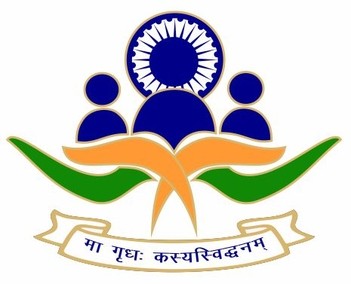
- 26 Feb 2025
Context:
In February 2025, the Supreme Court of India stayed a controversial order issued by the Lokpal, which had attempted to bring High Court judges within its jurisdiction by categorizing them as "public servants" under the Lokpal and Lokayuktas Act, 2013. The apex court termed the Lokpal’s interpretation as “very disturbing” and in contradiction with settled constitutional principles.
Understanding the Lokpal and Its Jurisdiction
Origin and Legal Framework:
- Concept Origin: The term "Lokpal" was coined by Dr. L.M. Singhvi in 1963. The concept was originally inspired by the Swedish institution of the Ombudsman (1809).
- Legislative Foundation: The Lokpal and Lokayuktas Act, 2013 was passed following public pressure during the Anna Hazare-led India Against Corruption movement.
- Purpose: To act as an independent anti-corruption body with jurisdiction over high-ranking public officials.
Structure and Jurisdiction:
- Composition:Lokpal comprises a Chairperson and up to 8 members (50% must be judicial).
- Selection Committee: Includes the Prime Minister, Speaker of Lok Sabha, Leader of Opposition, Chief Justice of India, and an eminent jurist.
- Jurisdiction (Section 14):
- Prime Minister (with exceptions related to national security, international relations, etc.)
- Union Ministers and Members of Parliament
- Government servants (Group A-D)
- Chairpersons, officers of public entities, and NGOs receiving foreign contributions over ?10 lakh annually
The Controversy: Inclusion of High Court Judges
The Lokpal recently issued an order stating that High Court judges qualify as public servants under the Lokpal Act. The reasoning was based on historical foundations:
- Lokpal’s Argument:
- High Courts were established under British-era laws like the Indian High Courts Act, 1861.
- Article 214 of the Constitution merely recognizes these courts rather than creating them.
- Therefore, High Court judges should fall under Lokpal’s purview, unlike Supreme Court judges who are appointed under Article 124.
Supreme Court’s Response and Constitutional Position
The Supreme Court overruled Lokpal’s interpretation, citing constitutional provisions and established legal precedent:
- Appointment under the Constitution:
- High Court judges are appointed under Article 217 of the Constitution.
- Supreme Court judges are appointed under Article 124.
- Both are constitutional functionaries and hence outside the jurisdiction of Lokpal, which is a statutory body.
- 1991 K. Veeraswami Judgment (Five-Judge Bench):
- Unanimously held that judges are public servants, but no criminal case can be registered against them without prior consultation with the Chief Justice of India (CJI).
- Even if the CJI is the accused, the consultation must occur with other senior SC judges.
- Emphasized judicial independence and the need for protection against frivolous or motivated inquiries.
- Judicial Integrity vs Public Scrutiny:
- While corruption among judges is not immune to scrutiny, the procedure must ensure judicial independence, prevent erosion of public trust, and protect honest judges from harassment.
Critical Analysis: Lokpal's Overreach and Constitutional Boundaries
- Violation of Doctrine of Separation of Powers:The Lokpal's attempt to extend its reach to constitutional judges infringes on the independence of the judiciary, a basic feature of the Constitution.
- Constitutional Supremacy vs Statutory Authority:The Lokpal, being a creation of Parliament, cannot override the constitutional safeguards provided to judges under Articles 124 and 217.
- Judicial Precedent Binding on Statutory Bodies:Ignoring the K. Veeraswami judgment not only undermines legal precedent but also reflects a lack of institutional discipline.
Conclusion
The recent conflict between the Lokpal and the Supreme Court over jurisdictional boundaries highlights the delicate balance between ensuring accountability and preserving judicial independence. While combating corruption remains vital, procedural safeguards and constitutional norms must guide such actions. The episode reiterates the importance of institutional clarity, inter-agency respect, and adherence to constitutional principles in India's democratic framework.
RBI’s Liquidity Infusion of ?1.5 Lakh Crore
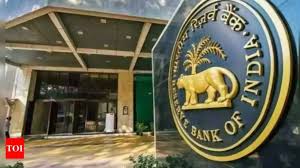
- 04 Feb 2025
In News:
In January 2025, the Reserve Bank of India (RBI) announced its largest monetary easing since the COVID-19 pandemic, unveiling a multi-pronged plan to inject over ?1.5 lakh crore into the money markets.
This move aims to address liquidity shortfalls caused by RBI’s forex interventions and signal possible easing in the upcoming monetary policy review.
Context: Why Liquidity Infusion Was Needed
- Forex Intervention: RBI sold over $50 billion from its foreign exchange reserves to stabilise the rupee, in response to large-scale equity sell-offs by Foreign Institutional Investors (FIIs).
- Impact: These interventions reduced rupee liquidity, tightened short-term interest rates, and raised borrowing costs.
- Liquidity Deficit: Market estimates pegged the shortfall at ?3 lakh crore.
Key Liquidity Measures Announced by RBI
- Government Bond Buy-Back: ?60,000 Crore
- Conducted in three tranches on January 30, February 13, and February 20, 2025.
- Objective: To inject liquidity into the banking system by repurchasing government securities before maturity.
- 56-Day Variable Rate Repo Auction: ?50,000 Crore
- Scheduled for February 7, 2025.
- Enables banks to borrow short-term funds by offering government securities as collateral at a market-determined interest rate.
- USD/INR Buy-Sell Swap Auction: $5 Billion
- A six-month forex swap in which RBI borrows dollars in exchange for rupees and agrees to buy them back later.
- Helps stabilize the rupee without draining rupee liquidity.
Significance of the Measures
- Monetary Transmission: With adequate liquidity, any potential repo rate cut will be more effectively transmitted through lower lending rates, boosting investment and consumption.
- Financial Stability: By calming money markets and moderating borrowing costs, RBI strengthens confidence amid global uncertainties.
- Rupee Management without Liquidity Squeeze: The forex swap allows rupee liquidity to remain intact while addressing exchange rate volatility.
Governor’s Focus Areas:
In a meeting with private sector bank heads ahead of the February monetary policy review, RBI Governor Sanjay Malhotra highlighted the following priorities:
- Financial Stability & Inclusion
- Enhanced Digital Literacy and Credit Access
- Improved Customer Service & Grievance Redressal
- Cybersecurity & IT Risk Management
- Monitoring of Third-party Service Providers
- Countering Rising Digital Fraud
Beware of Digital Wedding Invites

- 08 Dec 2024
In News:
In the peak wedding season, cyber fraudsters are increasingly exploiting digital wedding invitations to hack into mobile phones. These fraudulent invites, often disguised as PDF wedding cards shared on WhatsApp, contain embedded malware that allows cybercriminals to gain full access to the victim's phone. This includes access to sensitive financial data, making individuals vulnerable to fraud. The Lucknow Police Cyber Cell has issued a public warning, urging citizens to be cautious and avoid opening suspicious files.
How the Scam Works
The scam involves cybercriminals sending out malware-laden wedding invitations. Once the recipient opens the file, the malware infects their phone, enabling the fraudsters to remotely control the device. From there, they can access sensitive information, including bank account details, and may even transfer funds without the victim’s consent.
Preventive Measures and Cyber Hygiene
To protect against such scams, individuals should follow these preventive steps:
- Avoid Suspicious Files: Do not open files from unknown senders, particularly those with extensions like APK, PIF, or VBS. It is crucial to verify the sender's number—legitimate Indian numbers typically begin with +91.
- Turn Off Auto-Download: Disabling automatic downloads on platforms like WhatsApp can prevent files from being opened unknowingly.
- Enable Two-Step Verification: Strengthen security by activating two-step verification on your digital accounts and setting strong passwords.
- Report Fraud Immediately: In case of suspicious activity, contact the cybercrime helpline at 1930 or file a complaint on the official cybercrime portal (www.cybercrime.gov.in).
The Lucknow Police’s “Cyber Pathshala” campaign aims to raise awareness and educate the public on digital scams, particularly during the wedding season when these frauds are at their peak.
Cybersecurity Challenges in India
This emerging digital threat is part of a broader trend of sophisticated cybercrimes in India. Cyber fraudsters are increasingly using manipulative tactics, such as phishing, fake digital arrests, and malware attacks. In 2024, India witnessed a significant rise in ransomware attacks, frauds targeting financial institutions, and supply chain vulnerabilities.
India's legislative and institutional frameworks are evolving to address these challenges. Key measures include:
- The Information Technology Act, 2000, which lays the foundation for tackling cybercrimes.
- The Digital Personal Data Protection Act, 2023, which focuses on protecting personal data.
- The Indian Computer Emergency Response Team (CERT-In), which coordinates national responses to cyber incidents.
Additionally, new frameworks like the National Cyber Security Policy, 2013, and initiatives such as Cyber Surakshit Bharat and the Indian Cyber Crime Coordination Centre (I4C), aim to fortify India's digital landscape and promote cybersecurity.
Emerging Cyber Threats
As India becomes more digitally connected, the threat landscape continues to evolve:
- Digital Arrest Scams: Fraudsters impersonate law enforcement to extort money from victims, claiming they are under investigation for fictitious crimes.
- Ransomware: Attacks on critical infrastructure, such as financial institutions and healthcare systems, have led to operational disruptions and financial losses.
- Deepfake Technology: The rise of AI-generated deepfakes poses significant risks, including misinformation and financial fraud.
- Internet of Things (IoT) Vulnerabilities: The rapid adoption of IoT devices has created new security challenges, with many devices lacking adequate protection.
Strategic Recommendations for Enhancing Cybersecurity
To counter these evolving threats, India must focus on several strategic areas:
- Digital Literacy Campaigns: Nationwide efforts to improve digital literacy, particularly targeting vulnerable groups such as rural populations and senior citizens.
- Stronger IoT Security Protocols: Mandating secure design and certification for IoT devices.
- AI-Driven Threat Intelligence: Implementing AI-based tools for early threat detection and response in critical sectors.
- Mandatory Cybersecurity Audits: Regular audits of critical infrastructure, especially in sectors like healthcare, banking, and utilities.
- Public-Private Collaboration: Strengthening partnerships to address challenges such as cryptocurrency fraud, ransomware, and dark web-enabled crimes.
Conclusion
The rise of digital fraud, including the manipulation of wedding invitations for malicious purposes, highlights the need for enhanced cybersecurity measures in India. By improving public awareness, investing in technological solutions, and reinforcing legal and institutional frameworks, India can better protect its citizens from the growing threat of cybercrime. A proactive and informed approach is essential to secure the digital future of the nation.
Arctic Sea Ice Changes May Alter India's Monsoon Patterns
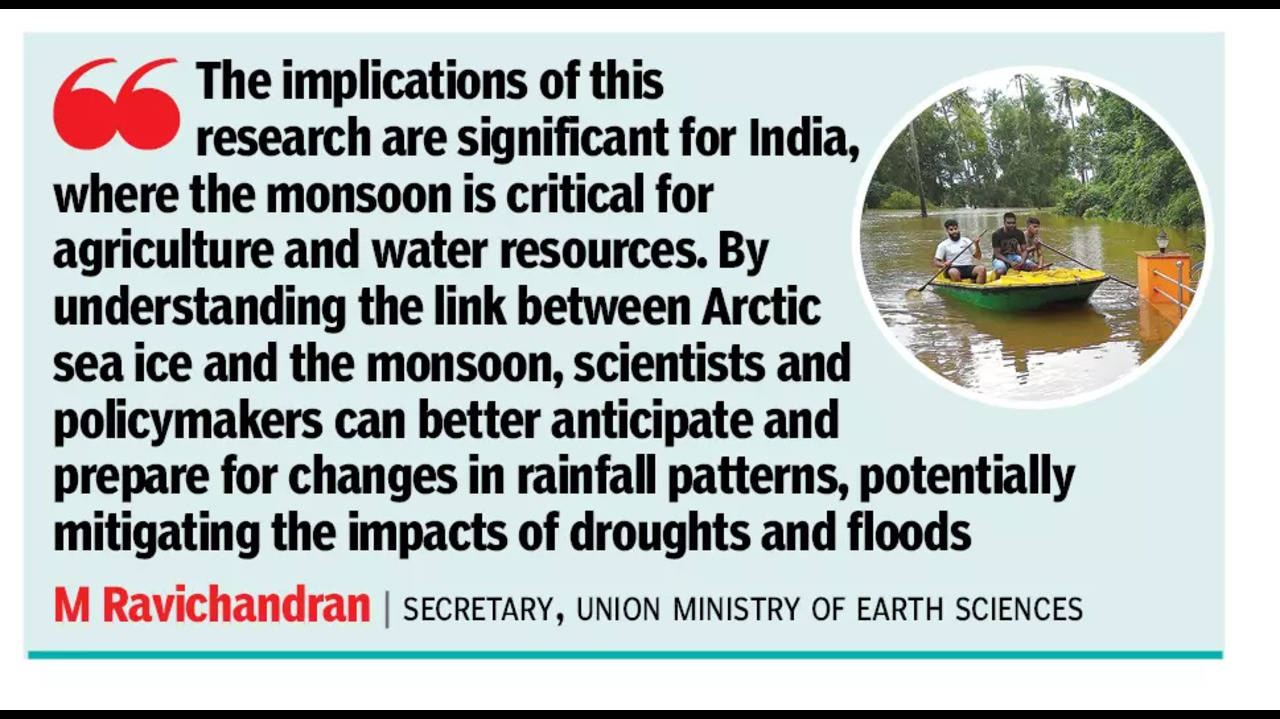
- 09 Sep 2024
In News:
A study by researchers from India’s National Centre for Polar and Ocean Research (NCPOR) has found that seasonal variations in Arctic Sea ice are impacting the Indian monsoon.
What is the Indian Summer Monsoon Rainfall?
The Indian Summer Monsoon Rainfall (ISMR), occurring from July to September, is one of the most significant monsoon systems globally. During the summer, the Central Asian and Indian landmasses heat up more quickly than the surrounding oceans. This temperature difference creates a low-pressure zone at the Tropic of Cancer known as the intertropical convergence zone (ITCZ). Trade winds from the southeast are then deflected toward the Indian subcontinent due to the Coriolis effect and the low pressure they encounter after crossing the equator. As these winds pass over the Arabian Sea, they pick up moisture and bring rain to India. The southwest monsoon divides into two branches over the Indian landmass. The Arabian Sea branch delivers rain to the west coast, while the Bay of Bengal branch brings rain to the eastern and northeastern parts of India. These branches converge over Punjab and Himachal Pradesh, with the Arabian Sea branch moving inward and the Bay of Bengal branch following the Himalayas.
Complexity of the Indian Summer Monsoon Rainfall
Recent climate models have revealed that the ISMR is influenced by the surface temperatures of the Indian, Atlantic, and Pacific Oceans. Additionally, the circum-global teleconnection (CGT), a large-scale atmospheric wave at mid-latitudes, also plays a significant role in affecting the monsoon.
Influence of Arctic Sea Ice on the Indian Monsoon
The study indicates that reduced sea ice in the central Arctic results in decreased rainfall in western and peninsular India, but increased rainfall in central and northern India. Conversely, lower sea ice levels in the upper latitudes, especially in the Barents-Kara Sea region, delay the onset of the monsoon and make it more unpredictable.
Other Atmospheric Systems Influencing the Pattern
When sea ice levels in the central Arctic rise, the heat transferred from the ocean to the atmosphere triggers cyclonic circulation at lower latitudes, such as the North Atlantic. This process enhances Rossby waves—fast-moving air currents created by Earth's rotation and temperature differences—which move from west to east. These waves cause high pressure over northwest India and low pressure over the Mediterranean region, strengthening the Asian jet stream over the Caspian Sea and shifting the subtropical easterly jet northward. This shift leads to increased rainfall in western and peninsular India. On the other hand, decreased sea ice in the Barents-Kara Sea generates an anticyclonic circulation (clear skies) over northwest Europe. This disturbance affects the upper atmosphere over subtropical Asia and India, resulting in increased rainfall in northeastern India while leaving central and northwest regions drier.
Role of Climate Change
Climate change accelerates the reduction of Arctic sea ice, which intensifies the variability and unpredictability of the ISMR. Lower Arctic sea ice contributes to more frequent and severe droughts in some areas, while causing excessive rainfall and flooding in others. The study underscores the urgent need for expanded research on climate dynamics and more accurate monsoon forecasts to address these changing patterns.
Biofuels and Global Biofuels Alliance (TOI)
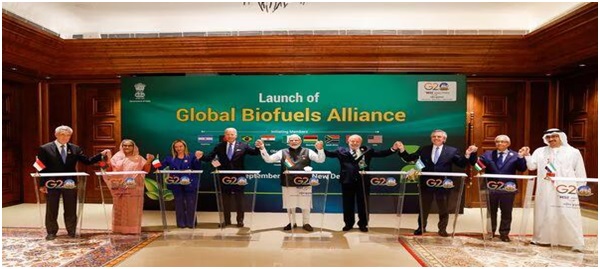
- 01 Nov 2023
Why is it in the News?
The Global Biofuel Alliance, formed during the recent G20 summit in India, aims to support the development and deployment of sustainable biofuels.
What are Biofuels?
- Biofuels are sustainable fuels made from a variety of organic materials (e.g. wood, crops, oil, algae, organic residues, etc.) called biomass.
- According to the International Energy Agency (IEA), biofuels are liquid fuels derived from biomass.
- It can be used as an alternative to fossil fuel-based liquid transportation fuels such as gasoline, diesel and aviation fuels.
How are Biofuels Produced?
- Biofuels can be produced from several methods or production pathways, including transesterification, hydrotreating, gasification, Fischer-Tropsch synthesis, fermentation and pyrolysis.
- Biofuels are generally divided into four categories – or generations – according to feedstock – or the type of biomass – used.
- First-generation biofuels, known as conventional biofuels, are produced from agricultural food crops, vegetable oil, and food waste.
- Higher carbon content and emit greenhouse gases.
- Second-generation biofuels, called advanced biofuels, are made from energy crops, agricultural or forest residue, known as lignocellulosic biomass.
- Greenhouse content less than 1st generation biofuel
- Third-generation biofuels are made from the byproducts of microorganisms, such as algae, natural organisms that can be rapidly produced with little energy and without disrupting ecosystems.
- Carbon Neutral (CO2 emitted=CO2 sequestered)
- 4th Generation biofuels are produced from genetically engineered crops like GM crops, pyrolysis, gasification etc. and are Carbon Negative.
What are the advantages of Biofuels?
- Biofuel Availability: Biofuels can be produced in multiple locations and from diverse sources, making global production and distribution realistic.
- Renewable Energy: Biofuels come from plants, so we can keep growing them, making biofuels a sustainable energy source.
- Energy Independence: Using biofuels means we rely less on foreign oil, saving money on imports and boosting our energy security.
- Cleaner Environment: Biofuels produce fewer harmful gases compared to fossil fuels, which helps keep our environment cleaner.
- Income for Farmers: Biofuels can give farmers extra income, which aligns with the goal of doubling their earnings.
- Plenty of Biofuel Sources: We can make biofuels from different things like plants, waste, and algae, so there's a lot of it available.
What are the disadvantages of Biofuels?
- Biofuel sustainability: End-to-end sustainability is a key question, as biofuels must come from a green supply chain, starting with sustainable biomass production.
- Land used for biofuel production needs to be closely monitored, ensuring sustainable management practices and avoiding crop displacement.
- Resource Demand: Making biofuels needs a lot of land and water.
- In countries like India, where there's not much extra land for farming, it might not be a good idea to use it for biofuels.
- Competition with Food: Biofuel production and food production sometimes fight for the same land and resources.
- This can lead to higher food prices and make it hard for people to get enough to eat.
- Greenhouse Gases: Surprisingly, some biofuels can produce even more greenhouse gases than regular fossil fuels.
- This happens when we use land that was once covered in forests to grow crops for biofuels.
Are Biofuels a Replacement for Fossil Fuels?
- There is a difference between biofuels and sustainable biofuels according to experts.
- While 1G ethanol is considered a biofuel, experts categorize 2G ethanol as sustainable biofuels.
- The problem has gained significant attention recently due to the acceleration of climate change, raising worries about the threat to food security and the increasing loss of forests and biodiversity as a result of the increased area required for farming.
- Estimates show that far over half of all vegetated land is currently under cultivation, making agriculture one of the primary global sources of carbon emissions.
- The Global Biofuels Alliance (GBA) has said unequivocally that producing 2G ethanol would be its primary objective.
Biofuels and the Energy Shift:
When it comes to changing our energy sources, biofuels play a role:
- Right now, most biofuels are mixed with regular gasoline or diesel to some extent.
- India, for example, is increasing the use of 20% ethanol-blended petrol across the country by 2025.
- Some experts think that electric vehicles (EVs) and green hydrogen are the main focus for our energy future.
- But others believe that 2G ethanol can help in the transition. It can reduce greenhouse gas emissions and keep internal combustion engines in use longer.
- This gives time for new alternatives to develop, helps farmers, and creates jobs.
What is the Global Biofuels Alliance (GBA)?
- The Global Biofuel Alliance (GBA) is an initiative by India as the G20 Chair.
- The Alliance intends to expedite the global uptake of biofuels through facilitating technology advancements, intensifying the utilization of sustainable biofuels, and shaping robust standard setting and certification through the participation of a wide spectrum of stakeholders.
- The alliance will also act as a central repository of knowledge and an expert hub.
- GBA aims to serve as a catalytic platform, fostering global collaboration for the advancement and widespread adoption of biofuels.
- This transition aims to reduce reliance on fossil fuels, create employment opportunities, and stimulate economic growth.
- Members: The GBA has already gained support from 19 countries and garnered the interest of 12 international organizations.
- Notably, seven G20 countries, including Argentina, Brazil, Canada, India, Italy, South Africa, and the United States, are actively supporting the GBA
- Additionally, four G20 invitee countries (Bangladesh, Singapore, Mauritius, UAE) are also backing this initiative.
- Furthermore, eight non-G20 countries (Iceland, Kenya, Guyana, Paraguay, Seychelles, Sri Lanka, Uganda, and Finland) have agreed to be initiated members of the GBA.
- International organizations including, the World Bank, Asian Development Bank, World Economic Forum, World LPG Organization, UN Energy for All, UNIDO, Biofutures Platform, International Civil Aviation Organization, International Energy Agency, International Energy Forum, International Renewable Energy Agency, World Biogas Association.
How the GBA Operate?
- The GBA has a multifaceted approach to support the global development and deployment of sustainable biofuels.
- It provides capacity-building exercises across the entire biofuel production value chain and offers technical support for national biofuel programs.
- Moreover, the GBA aims to foster knowledge sharing regarding policy best practices among its members.
- The GBA plans to establish a virtual marketplace that helps industries, countries, ecosystem participants, and key stakeholders connect by mapping the demand and supply of biofuels.
- It will also facilitate the development, adoption, and implementation of internationally recognized standards, codes, sustainability principles, and regulations.
- These efforts are designed to incentivize the adoption and trade of biofuels on a global scale.
Significance for India:
- The GBA holds particular significance for India.
- It is a tangible outcome of India's G20 presidency, reinforcing the nation's global presence.
- Collaboration within the alliance provides additional opportunities for Indian industries, allowing them to export technology and equipment related to biofuels.
- This collaboration also accelerates existing Indian biofuel programs, such as PM-JIVAN Yojna, SATAT, and the GOBARdhan scheme.
- By doing so, it contributes to increasing farmers' income, creating job opportunities, and fostering overall development within the Indian ecosystem.
Steps taken by GOI to promote biofuels:
- Pradhan Mantri JI-VAN Yojana (2019): This scheme aims to create a system for commercial projects and boost Research and Development in 2G Ethanol production.
- GOBAR DHAN Scheme (2018): This scheme focuses on managing cattle dung and farm waste to create useful compost, biogas, and bio-CNG.
- This not only keeps villages clean but also increases the income of rural households.
- It was launched under the Swachh Bharat Mission (Gramin).
- Ethanol Blending: The 2018 Biofuel Policy set a goal to reach 20% ethanol blending and 5% biodiesel blending by 2030.
- However, the government now plans to achieve the 20% ethanol blending target by 2025-26 instead of 2030.
- National Policy on Biofuels (2018): This policy classifies biofuels into "Basic Biofuels" like 1G bioethanol and biodiesel and "Advanced Biofuels" like 2G ethanol, converting municipal solid waste into drop-in fuels, 3G biofuels, and bio-CNG.
- It provides financial and fiscal incentives to promote each category of biofuels.
- Repurpose Used Cooking Oil (RUCO): This initiative, launched by the Food Safety and Standards Authority of India (FSSAI), aims to collect and convert used cooking oil into biodiesel.
Conclusion
While biofuels hold potential in the fight against climate change, their practical viability remains uncertain. In countries like India, where agricultural surplus is limited, their role as a major energy source may be challenging. Nevertheless, biofuels can still contribute to a greener future through sustainable production and consumption practices. The success of the GBA will determine the extent to which biofuels can play a meaningful role in addressing climate change and energy needs.
Vision document to make India a $30 trillion economy by 2047 (TOI)
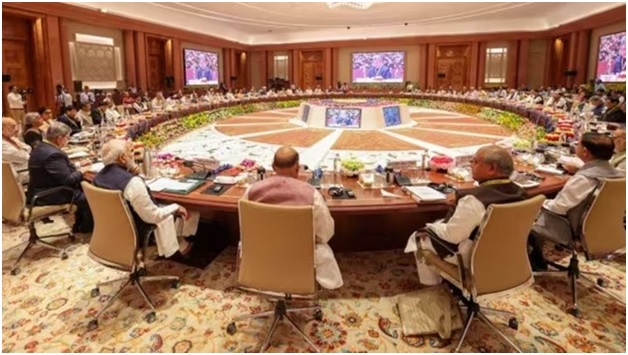
- 31 Oct 2023
Why is it in the News?
India will aim to become a ‘developed nation’ by 2047, with an economy of $30 trillion in its 100th year of independence, which will be propelled by radical policy changes and reforms in governance by 2030.
News Summary:
- The 'Viksit Bharat @2047' document, which outlines this vision, is nearing completion, following its inception in December 2021 by Prime Minister Narendra Modi.
- Ten sectoral groups of secretaries (SGoSs) were entrusted with the task of preparing sector-specific visions, and these are nearly finalized.
- Niti Aayog will consolidate these sectoral visions into a single comprehensive document by December, following consultations with SGoSs and thought leaders, including industry leaders.
- Prime Minister Modi is expected to unveil this vision document in December or January.
What is the Current State of the Indian Economy?
- India’s economy was $3.5 trillion in FY23, but currently with a GDP of $3.7 trillion, it is estimated to be the 5th largest economy in the world and according to some projections, India's GDP will surpass that of Germany and Japan by 2030.
- The country’s per capita income was estimated at around $2,500 in FY23.
- Nations with per capita income beyond a threshold of $17,000 are considered as developed.
- This rapid rate of economic expansion would result in India becoming the second-largest economy in the Asia-Pacific region.
NITI Aayog Vision India@2047 Document:
- The process of shaping the Vision India@2047 document commenced in December 2021.
- To ensure comprehensive coverage, ten groups of secretaries were assembled, each focused on distinct sectors such as rural and agriculture, infrastructure, social vision, welfare, technology, governance, security, foreign affairs, and more.
- This document will provide a blueprint for achieving the ambitious goal of transforming India into a $30-trillion developed economy by 2047, with a per-capita income ranging from $18,000 to $20,000.
- It will encompass a range of crucial elements, including re-engineering government processes, implementing reforms, and streamlining the efforts of various ministries and departments to eliminate redundancy.
- Expect insights into India's global involvement in areas like trade, investment, technology, capital flows, and research and development.
- Furthermore, the document will shed light on which Indian companies are poised to lead on the global stage and the strategic approach for nurturing the ecosystem required to realize this vision.
- It will also delve into matters related to human capital development, leveraging the nation's vast market size, and addressing regional disparities.
- The vision document will also provide a roadmap, delineating where India aims to be in 2030 and, ultimately, in 2047."
What are the obstacles ahead in implementing the Vision India@2047?
- NITI Aayog is assisting Gujarat and Andhra Pradesh in preparing their vision documents in order to bring them into compliance with the national vision document.
- While other states, such as Uttarakhand, Goa, Tamil Nadu, and Uttar Pradesh, are working on their own documents.
- Middle-income trap: The plan will include safeguards to make sure the economy stays out of the "middle-income trap".
What is the middle-income trap?
- According to the World Bank, the term "middle-income trap" describes a scenario in which a nation with a middle-class income is unable to make the transition to a high-income economy because of growing expenses and a decrease in its competitiveness.
- It's when per capita income reaches around $5,000 to $6,000, and then progress slows down.
- Low-income countries often tend to transition faster to middle-income levels, driven by low wages, cheap labour and basic technology catch-up.
- However, only a few countries manage to achieve high-income status.
What are the reasons for the middle-income trap?
- An example of what is known as the "middle-income trap" is when labour wages become so high that a middle-income nation is unable to compete on a global scale in the production of standardized, labour-intensive goods.
- But because of its relatively low productivity, it is also unable to compete on a large enough scale in higher value-added activities.
- As a result, growth is slowing, wages are stagnant or falling, and the informal economy is expanding.
Countries that are stuck in the middle-income trap:
- Historically, some evidence suggests that Latin American and Middle Eastern countries suffered middle-income traps for at least four or five decades.
- According to a World Bank report, out of 101 middle-income countries in 1960, only 13 countries achieved high-income status by 200
- The most recent examples are Brazil and Mexico, which were touted to transition to developed economies but failed to achieve the same success as Japan or some countries in Eastern Europe.
What Strategies Can Help India Overcome Middle-Income Traps?
- Investment: India should aim for an investment-to-GDP ratio of 35%. Achieving this goal requires boosting savings to 32% of GDP.
- In the fiscal year 2022, savings and investment rates were 30.2% and 29.6%, respectively, indicating the need for further growth.
- Balancing Fiscal Consolidation with Growth: India faces a challenge with a general public debt of 83% of GDP and high fiscal deficits.
- Balancing fiscal consolidation while meeting targets set under the Fiscal Responsibility and Budget Management (FRBM) framework is crucial.
- Structural Reforms: The Asian Development Bank (ADB) emphasizes the need for structural reforms in India to address issues like structural bottlenecks, declining investment, and an increasing current account deficit.
- Notable reforms include the Insolvency and Bankruptcy Code (IBC), which has strengthened the country's banking systems.
- Education and Skill Development: Skill development is vital for enhancing labour productivity and promoting inclusive growth.
- Recent reports suggest that employability among young people needs improvement, emphasizing the importance of education and skill enhancement programs.
- Research, Development, and Innovation: Innovation plays a significant role in transforming India's economy. India's progress in the Global Innovation Index reflects its potential.
- Initiatives like the CoWin platform for monitoring vaccination programs and the development of data ecosystems through platforms like UPI and Aadhaar are driving India's growth.
- Climate Change Adaptation: India should focus on developing and customizing adaptation technologies and solutions to address climate-induced vulnerabilities.
- This includes addressing challenges in agricultural production, food security, disaster risks, resource access (water, power, coastal resources), and human health in the face of climate change.
India's Digital Personal Data Protection Bill 2023 (TOI)

- 04 Aug 2023
- The central government will notify countries where data fiduciaries may transfer personal data.
- Such transfers will be subject to prescribed terms and conditions.
- Exemptions:
- Certain specified cases will be exempt from certain rights of data principals and obligations of data fiduciaries, excluding data security. These cases include:
- Prevention and investigation of offenses.
- Enforcement of legal rights or claims.
- The central government may, through notification, exempt certain activities from Bill's application, such as
- Processing by government entities for national security and public order.
- Data processing for research, archiving, or statistical purposes.
- Data Protection Board of India:
- The central government will establish the Data Protection Board of India.
- Key functions of the Board include:
- Monitoring compliance and imposing penalties.
- Directing data fiduciaries to take necessary measures in the event of a data breach.
- Addressing grievances made by affected individuals.
- Penalties:
- The Bill outlines penalties for various offenses, including
- Fines of up to Rs 200 crore for non-compliance with obligations related to children's data.
- Fines of up to Rs 250 crore for failure to implement adequate security measures to prevent data breaches.
Importance of the Digital Personal Data Protection Bill, 2023:
- The Digital Personal Data Protection Bill 2023 holds significant value as it aims to ensure the safety and privacy of users’ personal data while granting them greater control over its portability. The bill sets forth stringent measures and norms that will hold big corporations and consumers accountable, imposing substantial fines on those who fail to comply.
- The primary objective of the bill is to enhance the accountability of entities, including internet companies, mobile apps, and businesses, in their collection, storage, and processing of citizens' data, safeguarding the citizens' "Right to Privacy." Once approved, various public and private entities will be obligated to obtain explicit consent from users before collecting and processing their data.
- This landmark legislation signifies a major step towards valuing and protecting the privacy of each consumer, ensuring that their personal data is handled with utmost care and responsibility, creating a safer and more secure digital environment for all.
Concerns regarding the Digital Personal Data Protection Bill, 2023, include several contentious issues:
- The government and its agencies are granted wide-ranging exemptions.
- The powers of the data protection board might be diluted.
- The proposed amendment to the Right to Information Act, of 2005, is causing worries, particularly due to the removal of the public interest caveat that could restrict sharing of government officials' personal information.
- The bill overrides Section 43A of the Information Technology Act, 2000, which mandates compensation for mishandling user data by companies. The new compensation mechanism has been questioned, as it may impact users' ability to seek adequate redress.
- Addressing these concerns is essential to ensure a comprehensive and balanced approach to safeguarding personal data in the digital realm.
What are Data Privacy Regulations in Other Countries?
- Approximately 70% of countries worldwide have implemented data protection legislation, as reported by the United Nations trade agency UNCTAD.
- The EU's General Data Protection Regulation (GDPR), enforced in 2018, is considered the most stringent privacy and security law globally and serves as a benchmark for data protection regulations.
- Several countries, such as China and Vietnam, have recently strengthened their laws concerning the cross-border transfer of personal data to enhance data privacy.
- In 2018, Australia passed a bill granting police access to encrypted data.
In conclusion, the Digital Personal Data Protection Bill, 2023, offers extensive rights to individuals, granting them enhanced visibility, awareness, decision-making autonomy, and control over their data. It imposes strict obligations on companies to adhere to individual rights and establishes robust redressal mechanisms, backed by significant penalties for non-compliance.
Moreover, the Bill reinforces the landmark judgment of the Supreme Court in the case of Justice K. S. Puttaswamy (Retd) Vs Union of India (2017). In this judgment, a nine-judge bench unanimously recognized the constitutionally protected fundamental right to privacy for Indians, affirming that privacy is an intrinsic aspect of life and liberty under Article 21 of the Constitution. The Digital Personal Data Protection Bill, 2023, is a crucial step towards upholding this fundamental right and ensuring better protection of personal data in the digital age.
Mains Question:
- Examine the provisions and significance of the Digital Personal Data Protection Bill, 2023, comparing it to global data privacy regulations and its alignment with the Indian Supreme Court's right to privacy ruling. (15M)
